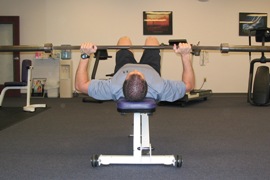This particular Functionally Fit feature is a first in a series of exercises you can use to maximize shoulder functionality and health. Visit our archives and continue to check out our E-News to view the entire series as well as all Functionally Fit exercises.
Execution


Whether using dumbbells or a barbell, slowly lower the weight until the upper arms are parallel to the floor.
Pause at the bottom for one to two seconds, then press the weight back up. Reps and sets may vary based upon the training effect you seek. While this approach goes against conventional training methodology, I am convinced, based on personal experience and years of rehabbing shoulders, that repetitive loading beyond this range of motion exposes the rotator cuff and joint to harmful stress.
Application
This exercise is still very effective in targeting the pectoralis muscle group, shoulders and triceps. I train all of my clients in this fashion regardless of past or present shoulder injuries. Keep in mind that repetitive heavy loading with full range of motion may lead to:
Rotator cuff tendonitis (specifically, the supraspinatus)
Increased laxity of the anterior shoulder capsule
Acromioclavicular joint inflammation
Increased risk for pectoralis major tears
Increased risk for anterior shoulder subluxation/dislocation (namely in population with previous history of this and under age 30)
Additional Notes
I apply the same motion restriction principle to chest flies and push-ups to reduce rotator cuff injuries and overall wear-and-tear on the shoulder joint over time. Risk simply outweighs reward over time, and loading the joint maximally at its weakest point will eventually lead to mechanical failure.
Brian Schiff, PT, CSCS (www.brianschiff.com) is a licensed physical therapist, respected author and fitness professional. He became a Certified Strength and Conditioning Specialist (CSCS) in 1998. In 2000, he opened his own personal training and sport specific conditioning facility, Fitness Edge, in















